

Note: Click on Solar System Exploration: Galileo Legacy Site (NASA-JPL) to get this image at its highest resolution.
Highest resolution picture of asteroid 951 Gaspra.
Gaspra is an irregular body with dimensions about 19 x 12 x 11 kilometers (12 x 7.5 x 7 miles).
The north pole is located at upper left.
The sun is shining from the right; phase angle is 50 degrees.
(This is the angle between the sun, Gaspra, and the observer; a phase angle
of 0 degrees means the sun is behind you, and a phase angle of 180 degrees
means the sun is behind the object you're looking at)
A striking feature is the abundance of small craters - more than 600 craters,
100-500 meters (330-1650 feet) in diameter are visible here.
Note the "faceted" shape, indicating Gaspra had a violent collisional history.
This image was taken 10 minutes before closest approach on October 29, 1991,
at a range of 5,300 kilometers (3,300 miles).
This picture of asteroid Gaspra is a mosaic of two images.
The resolution, with features as small as 108 meters (354 feet) being about
54 meters/pixel (177 feet/pixel), is the highest for the Gaspra encounter,
and is about three times better than that seen in the previous slide.
At closest approach, Galileo was just 1.5 seconds and 5 kilometers (3 miles)
from the aim point -- a bull's-eye in planetary distances.
Dr. Michael Belton, Solid-State Imaging Experiment Team Leader, said,
"The key word out of this encounter is precision. It was like taking a picture
of a large house in San Francisco from Los Angeles."
Because the asteroid is small, its surface gravitational force is two
thousand times smaller than that of the Earth's, yielding an escape speed
of only 10 meters per second (22.3 miles per hour); an Olympic-caliber
sprinter could run himself into orbit!
A 200 pound man would weigh 0.1 pounds!
In this view, we can see an illuminated portion of Gaspra that is about 18
kilometers (11 miles) long from lower left to upper right.
The large inward bend along the asteroid's lower right edge is about 6
kilometers (3.7 miles) across, and the prominent crater on the center left
edge is about 1.5 kilometers (1 mile) in diameter.
Gaspra has far more small craters compared to larger ones than other,
previously studied bodies of comparable size, such as the moons of Mars.
This has implications for Gaspra's age (see "Cratering and Age Determination", below).
Even though several craters are visible on Gaspra, none approaches the scale
of the asteroid's radius.
Evidently, Gaspra lacks the large craters common on the surfaces of many planetary satellites.
This is consistent with the theory that Gaspra is of comparatively recent
origin from the collisional breakup of a larger body, a survivor of a series of catastrophic events.
In fact, Gaspra's current size may be only a tenth of its parent's original size.
The prominence of groove-like linear features, believed to be related to
fractures, are consistent with such a history.
These linear depressions, 100-300 meters (60-180 feet) wide and tens of
meters (tens of yards) deep, are in two crossing groups with slightly
different shapes, one group wider and more pitted than the other.
Grooves had previously been seen only on Mars's moon Phobos, but were predicted for asteroids as well.
Scientists can count craters on planets and asteroids as one way to tell the age of the surface.
You can test this for yourself by gathering up a paintbrush, some paint,
and a (large) piece of paper (alternatively, substitute water and a large
solid-colored piece of cloth like a bedsheet for the paint and paper).
Load the paintbrush up with paint, and then give it a few gentle shakes over the paper.
Now, stop and count the number of "craters" on the paper.
Repeat this exercise a few times (reloading the paintbrush each time;
using different colors of paint each time is a nice artistic variation).
You should notice several things:
The older the planet surface (e.g. the more time that you allow the paper to be "cratered"), the more craters present.
The newer craters tend to overlay and even completely hide the older craters
(this is easier to see when you use a different color of paint for each "cratering episode").
And, there tend to be more small craters than large craters (since there are
far more small asteroids and rocks that could hit another asteroid than there are large ones).
How does this apply to Gaspra?
We expect that Gaspra should, eventually, have a collision with a relatively large rock or asteroid.
Since we don't see any large craters on Gaspra that such a collision would
leave behind, this probably means that Gaspra is relatively young, and
simply hasn't picked up any major scars as yet
(much like how we can tell that a car is new because it doesn't have any scratches or dents).
Next slide: Central Andes of South America
Back to: Galileo To Jupiter
Link to: Solar System Exploration: Galileo Legacy Site (NASA - JPL)
Updated: September 18 '96
Best seen with MS Internet Explorer.
Back: ARVAL - Image Gallery
Messages: